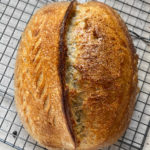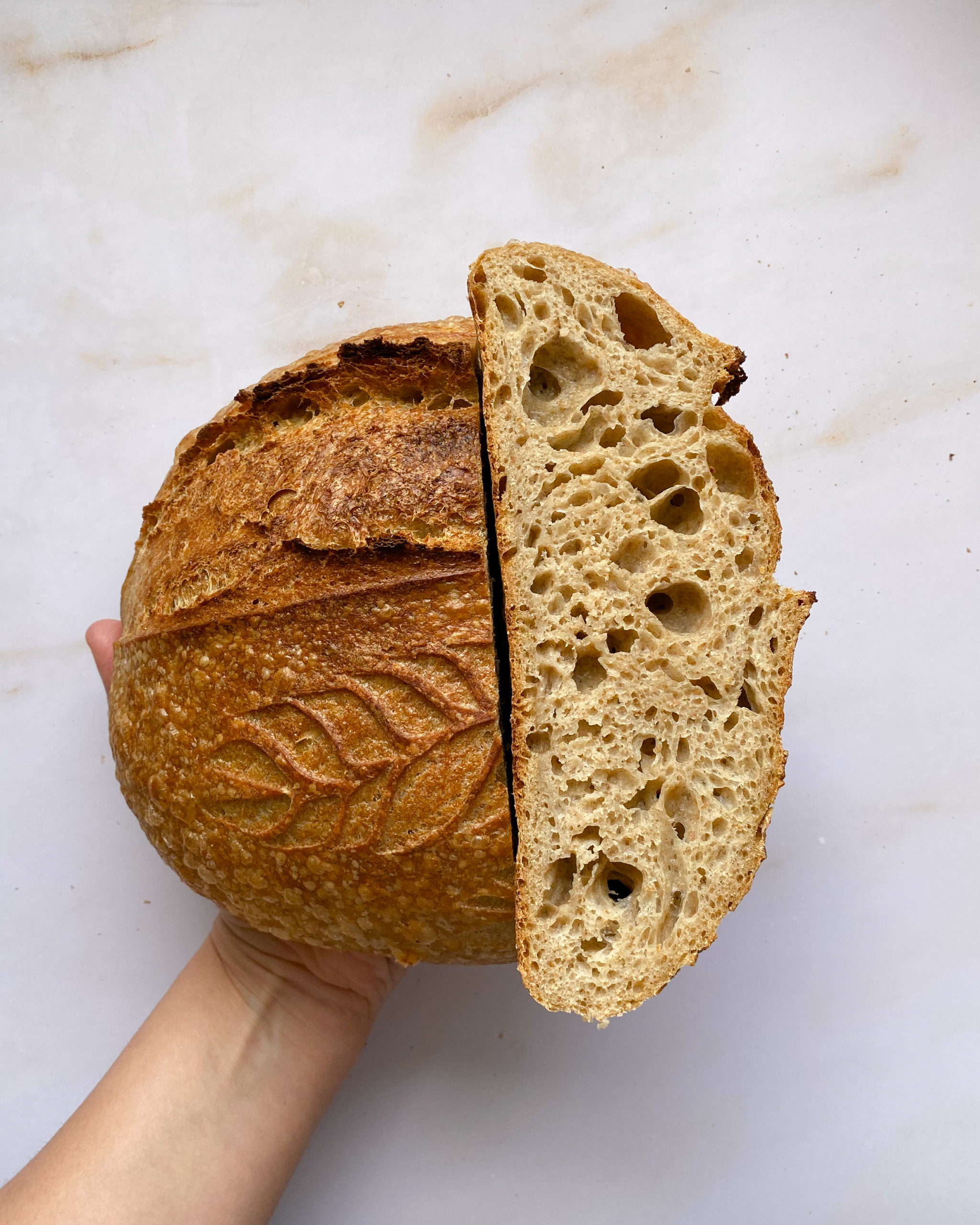Using 50% whole wheat flour and 50% bread flour, learn how to make this simple and incredibly flavorful sourdough bread.
Using Whole Wheat Flour in Bread
When you use a higher percentage of whole wheat flour in your dough, it will make for a tighter crumb but offer a bit more flavor. Why is that? Because when wheat is harvested it contains an endosperm, germ, and bran layer. Whole wheat flour continues to have all three, hence the name WHOLE wheat.
However, when the wheat flour is a bit more refined, leaving just the endosperm layer, it becomes white wheat flour. This refinement process is said to help make food a bit more digestible for some, a softer texture, and offers a more neutral flavor for baked goods.
What’s the Difference Between Whole Wheat and Whole Grain?
Whole wheat is essentially the same as whole grain as it contains the entire grain. This means that the wheat grain that is milled, is intact with all three of its main parts (bran, germ, and endosperm). While whole wheat is considered a whole grain, the term whole grain also encompasses other grains such as rye, rice, buckwheat, barley, bulgur, etc.
Is Whole Wheat Better For You than White Flour?
When you’re using whole wheat flour that contains all three elements: the endosperm, germ, and bran layers, that offers flavor, and of course, more nutrients and fiber. For this reason, many people think that whole grain bread is a bit more nutritious for you as it literally contains more nutrients. That doesn’t mean that traditional white bread doesn’t come without its own benefits, it just means that most of the time, homemade whole wheat bread contains more nutrients based on the type of flour you use.
This goes without saying that the quality of the bread you are eating also plays an important role here. If you are deciding between a “whole wheat” loaf of sandwich bread from the store with lots of additives and an artisan sourdough loaf (made with white flour, water, levain, and salt) from a local bakery (or micro bakery), chances are your body will benefit a whole lot more from that artisan loaf than any storebought sandwich loaf.
Why 50% Whole Wheat Sourdough Bread?
If you’re wondering why I use 50% rather than 75% or even 100% whole wheat flour, I think 50% offers loads of flavor, more nutrients, and doesn’t turn out quite as dense as 75% or higher. It’s important to note that what you buy at the grocery store or even most large-scale bakeries may not be what it seems. Because in truth, most whole wheat or whole grain bread sold at the store contains just about 20% give or take.
Try my Go-To Sourdough Bread Loaf recipe that uses just 20% whole wheat flour.
Fun fact: A good friend of mine back in high school used to work at a famous sandwich shop, which shall remain nameless. One day her manager admitted to her that the whole grain bread they used was really just brown-colored white bread. All of this to say that what most people might imagine is whole wheat bread really just contains some whole wheat flour (if that).
More Sourdough Recipes
If you’re looking for what to make next? Why not try any of these tasty homemade sourdough bread recipes:
Sourdough Bread with Orange-infused Oil
Whole Wheat Sourdough Bread Recipe Method
Total Dough Yield: 1,017g
Levain Percentage in the Dough: 15%
Total Hydration: 87% (This includes the hydration from the levain)
Recipe Total
537.5g Flour (100%)
467.5g Water (87%)
12g Salt (2.2%)
Recipe Specifics
100% | Whole Wheat Flour | 272g |
Bread Flour | 228g | |
86% | Water | 430g |
15% | Levain | 75g |
2.5% | Salt | 12g |
What You’ll Need:
Kitchen Scale: For consistent bread making, you really need a kitchen scale to measure by weight.
Sourdough Starter: My recipes use sourdough starter rather than yeast for leavening. If you don’t have one, ask around because you most likely know someone who would be willing to give you some of theirs. You can also buy them online!
Salt: I’ve tried this recipe with fine table salt and also coarse salt (sea salt or Kosher salt). My recommendation is fine table salt, but in a pinch coarse salt also works!
Water: If you normally drink the tap water where you live, you can use it in your sourdough bread, however, if you are hesitant, use bottled or filtered water!
Flours: Whole wheat flour, bread flour
Dutch Oven: If you don’t have a dutch oven you can use a baking stone.

How to Make 50% Whole Wheat Sourdough Bread
Equipment
- Kitchen Scale
- Lame or sharp knife
- Dutch oven or oven-proof combo cooker
Ingredients
For the Levain
- 15 g sourdough starter
- 17 g whole wheat flour
- 17 g bread flour
- 35 g water
For the Bread
- 272 g whole wheat flour
- 228 g bread flour
- 430 g water
- 75 g sourdough levain
- 12 g salt
Instructions
- Prepare the levain: combine your starter, flours and water and place in a tall jar or container to track the growth. It is ready to use when it has doubled in size (or just about). Temperature note: If you’ve got cold temps in your kitchen, leave it somewhere a bit warmer in the house ( about 25C/75F).
- Autolyse: Combine both flours together with the water in a bowl until no dry bits of flour are left. Cover your bowl (with a lid, wet towel, plastic wrap, etc.) and let that sit in a warm place (25C/75F) for about an hour.
- Add in your levain: Pour the sourdough starter on top of your dough and with wet hands dimple and pinch it into your dough until it is all combined. You can mix it in various ways (rubaud method, slap and fold, etc.). Once it has been incorporated, cover your dough again and leave for 10 minutes.
- Add in the salt: combine the salt with just 1 tsp of water and pour over the top of your loaf. Once again, dimple and pinch to mix it in until it is all combined. If you find your dough is really dry, you can add another 2 tsp of water to pinch in the salt. After it is all incorporated, cover your bowl and set it in a warm place. For me, that means making sure the temperature is between 22C-27C (the warmer the temperature the faster it will ferment).
- Bulk Fermentation: Let your dough sit to continue fermenting. Perform 3 sets of stretch and folds at 30 minute intervals to help give your dough structure and help to further develop the gluten. If you only have time to do 1, that’s not a problem. In total, the bulk fermentation can last from 3.5 to 6 hours or more. Note: In my kitchen, when the temp is 27C or warmer I need to watch it because it might ferment as quickly as 3 hours. Whereas, if the temp is 23-25C it might take anywhere from 4-6 hours to ferment. It’s all about measuring the temperature of your atmosphere and seeing how your dough is affected.
- Pre-shape: Pre-shaping helps to give your dough even more structure and a bit of tension. If I am making just one loaf, my preferred method is to give the dough one last coil fold in the bowl and let it sit again covered for about 20 minutes. You can also do this on the counter. Wet the counter with a spray bottle or just drop water down. Turn it out of the bowl onto the counter and fold the outside into the middle and form it into a ball.
- Final Shape: Dry off your counter space and sprinkle a bit of flour down to prevent sticking. Fold your dough and place in your banneton. Here you have two options, you can leave it to proof or you can let it sit and proof in the refrigerator to let the flavors develop even more. Note: leaving it in the fridge also makes it easier to score and helps it to have more oven spring. If you choose to leave it in the fridge, you can leave it anywhere from 2 to 48 hours.
- Bake: Preheat the oven 30 minutes, with the dutch oven inside, at 250C. Once the oven is hot enough, take the dough out of the fridge, turn it out onto parchment paper and give the dough a slice on the top (score) and place it in the dutch oven. Bake for 20 minutes with the lid on, then take the lid off to release the steam and get your crust crispy for 15 minutes and reduce the temp to 225C. Then take it out of the dutch oven, and place it alone on the rack for 15 minutes at 180C.The dough is finished cooking when the internal temperature reaches 95C/190-200F. Important: After taking it out of the oven, make sure to let your dough sit for at least 30 minutes to reduce a gummy interior.

